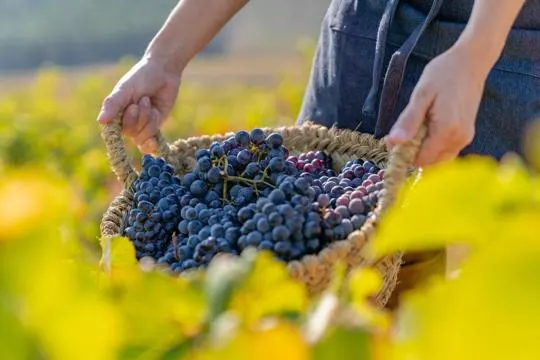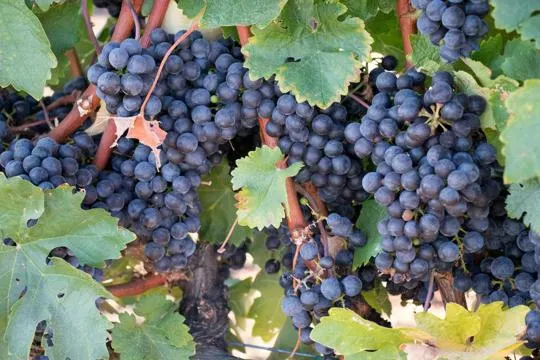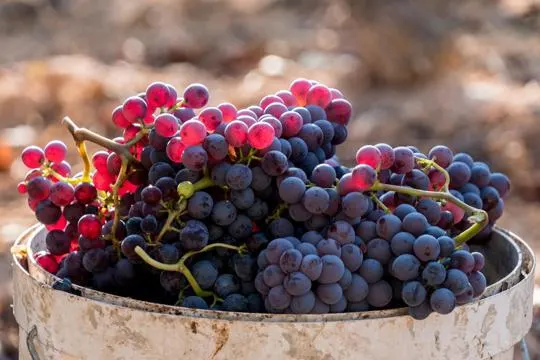Summary of key points
The main difference between grenache and garnacha lies in their origin and name. Grenache is a red wine grape that originated in France, while garnacha is the Spanish name for the same grape.
In terms of taste, both wines have similar characteristics with bold red fruit flavors and medium tannins. However, some argue that Spanish garnacha has a slightly smoother finish compared to French grenache.
Another distinction is their use in wine blends. Grenache is commonly used as a blending grape in wines like Châteauneuf-du-Pape, while garnacha is often featured as the main grape in Spanish red blends.
Whether you’re sipping on a glass of grenache or garnacha, these bold and flavorful wines are perfect for pairing with hearty meals or enjoying on their own.
Grenache and Garnacha are not twins separated at birth. Nope.
They’re the same grape! One’s just vacationing in France while the other parties in Spain.
In this universe, grape names get a makeover depending on their passport.
Ever sipped a wine so good you wanted to know its family tree? We have.
Our afternoons often involve unraveling the mysteries of our favorite wines.
Like detectives with a penchant for good vino.
Grenache or Garnacha, it’s a globe-trotter, loved everywhere.
And here we are, ready to spill the secrets. Join the grape gossip.
What is Grenache?

Grenache is a red wine grape that grows all around the world.
It is from Spain, where it is called Garnacha.
It loves hot climates and makes wines with high alcohol and low tannins.
This grape has dark berry flavors like blackberry and raspberry, along with hints of spice and earthiness.
It is often used in blends to give the wine complexity and depth.
It can even turn into rosé or white wines.
Grenache is special because it can fit different winemaking styles.
It can be aged in oak barrels to bring out its flavors, or made into lighter styles that show off its fresh fruit aromas.
People enjoy these wines because they are easy to drink.
In conclusion, Grenache is a fascinating grape that has lots of flavor and style.
You can have it on its own or with other grapes.
Wine lovers everywhere love its bold character and all the possibilities it brings.
What is Garnacha?

Garnacha is a grape varietal popular for making red and rosé wines.
It is thought to have started in Aragon, Spain.
Its thin-skinned berries give wines high alcohol content and low acidity.
This grape has become popular worldwide because of its versatility and ability to survive in diverse climates.
These wines are known for full-bodied flavors; dark fruits like blackberry and raspberry, with a hint of spice, tobacco, and herbs.
Its thin skin allows for the best extraction of these tastes during winemaking.
The wine can be light and fruity or rich and robust, depending on the winemaking methods.
Garnacha has the remarkable quality of enduring hot and dry conditions.
This makes it ideal for places with challenging climates like California’s Central Valley or the south Rhône Valley in France.
Also, Garnacha vines grow old beautifully, creating complex and deep-flavored wines as they age.
Garnacha is also used in fortified wines, such as Banyuls or Maury from France.
These sweet wines have higher alcohol content due to the addition of grape spirit during fermentation.
This makes a dessert wine with bold flavors that goes well with chocolate desserts or aged cheeses.
To sum up, Garnacha is a flexible grape variety that has become well-known around the world for its strong flavors and ability to adapt to different environments.
Whether it’s a light rosé or a powerful red wine, this grape offers a range of aromas and tastes that excite wine lovers worldwide.
Differences Between Grenache and Garnacha

Grenache and Garnacha may be used interchangeably, but they have distinctive traits.
Origin and Naming
Grenache and Garnacha are two wine grape varieties often used interchangeably.
But they have different origins.
These grapes are genetically identical, but subtle differences arise due to soil, climate, and winemaking techniques.
Grenache has its roots in Spain’s Aragon region, where it is called Garnacha.
It loves hot, dry, low-rainfall climates.
Its adaptability lets it grow in many terroirs around the world.
Grenache, as the French name suggests, comes from France.
It plays a big part in Southern Rhône blends.
Despite being the same varietal as Garnacha, Grenache has different characteristics due to soil, climate, and winemaking traditions.
Both Grenache and Garnacha produce wines with similar flavor profiles.
Red fruit notes like cherry and raspberry, plus hints of spice and earthiness.
Garnacha often has higher alcohol content and softer tannins than Grenache.
Spanish Garnachas are bold and vibrant, while French Grenaches are elegant and finesse.
It’s amazing how a single grape variety can be so different based on its environment.
Whether you choose Grenache or Garnacha, what matters is enjoying the nuances this versatile grape has to offer.
So next time you try these grapes, remember that while they share origins and genetics, the differences are in the glass, waiting to be discovered.
Growing Regions
Grow regions have a significant role in producing Grenache and Garnacha wines.
These grape varieties grow best in certain temperatures and landscapes, leading to special tastes and characteristics.
Grenache flourishes in warm Mediterranean areas, like Spain, France, and Australia.
The environment affects the grapes’ sugar levels, acidity, and tannins, influencing the wines’ flavor.
In these regions, Grenache grapes get lots of sun, which makes them ripe.
This causes wines with notes of ripe red fruits like strawberries and raspberries.
Plus, the warm temperatures give Grenache wines higher alcohol content.
These qualities make them great for pairing with heavy dishes or having on their own.
On the other hand, Garnacha is mainly grown in Spain’s Aragon region.
The dry climate and rough land present difficult growing conditions.
But, these issues bring out unique expressions of Garnacha wines.
The grapes have intense flavors from the arid environment, such as blackberry, plum, and spice.
Garnacha vines grow in hills with weak soils.
This leads to low yields, but high-quality grapes.
As a result, Garnacha wines often have thick flavors and delicate tannins that go great with many dishes.
To sum it up, it’s key to know the differences between growing regions when enjoying Grenache and Garnacha wines.
Whether you prefer Grenache’s sunny charm or Garnacha’s rugged beauty, exploring their distinct flavors will surely please wine lovers who want interesting experiences.
Flavor Profile and Taste
Grenache and Garnacha have a shared name, yet their flavors contrast faintly.
Grenache has a flavorful taste profile with hints of red fruits such as cherry, raspberry, and strawberry.
It has a medium to full body with moderate acidity and tannins.
Exploring flavor profiles further, Garnacha has similar fruity features, but more towards darker fruits like blackberry and plum.
This gives it a richer, more intense flavor.
Additionally, Garnacha usually has herbal or floral accents, adding complexity to its flavor.
Distinguishing between Grenache and Garnacha in terms of flavor profile and taste, Grenache has a vibrant mix of red fruit flavors with a hint of spice.
Whereas, Garnacha has a bolder mix of dark fruit flavors and herbal or floral nuances.
These nuances make each varietal special, and worth exploring for wine lovers seeking diverse tasting experiences but remaining close to their desired flavor palate.
Cultural Significance
Grenache and Garnacha have a rich history and global influence.
Both of these wine grapes have had an effect on various cultures, from France to Spain and beyond.
Grenache, also known as Garnacha, is highly valued in these countries.
This grape has been cultivated for centuries and comes from Spain.
It grows best in a warm climate and produces fragrant wines with flavors like red fruits and spices.
The cultural importance of Grenache is found in its versatility in winemaking.
It can be used to make rosé, red blends, and fortified wines.
It is popular all around the world and is enjoyed by many winemakers.
Grenache has also impacted social life in many communities.
It gives people job opportunities and helps the economy, particularly in places like Rhône Valley in France and Rioja in Spain.
The locals honor Grenache through festivals and events that show off its variety.
Grenache and Garnacha are the same grape, but they have different cultural significances.
For example, Garnacha is an essential part of Spanish culture since it is grown a lot in that country.
Similarities Between Grenache and Garnacha

Grenache and Garnacha have many similarities.
Both are used for winemaking, and come from Spain.
They make full-bodied red wines with high alcohol content.
Versatility allows them to be used alone or in blends, from dry to sweet.
Flavor-wise, they share notes of ripe berries, spices, and herbs.
This makes them popular among wine-lovers.
However, they have differences too.
Grenache is often seen in France’s Rhône Valley, and used in blends with Syrah and Mourvèdre for wines like Châteauneuf-du-Pape.
Whereas, Garnacha is mostly grown in Catalonia and Aragón, and features in Priorat wines.
When it comes to style, Grenache wines are more elegant, with softer tannins.
Meanwhile, Garnacha wines are bolder and more robust, with strong tannins.
Grenache vs Garnacha: Which Name is Used Where?
Grenache and Garnacha? Two names for the same grape.
In France, Grenache is popular.
In Spain, it’s Garnacha.
But both mean the same thing.
France loves Grenache.
It’s used in Rhône Valley and Languedoc-Roussillon wines.
It’s versatile, adding body, fruitiness, and spice.
A cornerstone of French winemaking.
Garnacha is beloved in Spain.
It grows in warm places like Rioja and Priorat.
Spanish winemakers prize it for making full-bodied reds.
Bursting with dark fruit, spice, and earthy notes.
Don’t forget – Grenache is an Anglicized version.
Garnacha keeps its original Spanish pronunciation.
A nod to the two countries’ unique winemaking styles.
Grenache and Garnacha in Winemaking
Grenache and Garnacha, two names for the same grape.
This powerhouse of winemaking is renowned for its ability to adapt.
It brings complexity and richness to blends and also offers a smooth mouthfeel.
Plus, it has a unique history – believed to be from Spain’s Aragon region.
Then, it spread to France’s Rhône Valley and is often blended with Syrah and Mourvèdre.
Garnacha is the Spanish name for the grape.
It thrives in regions like Priorat and Rioja, producing full-bodied wines.
Spanish winemakers are embracing its potential through old vine plantings and winemaking techniques.
Grenache and Garnacha share genetic ties, but different cultural contexts.
No matter the interpretation, these grapes bring diversity and complexity to wine worldwide.
Conclusion
Let’s conclude our Grenache and Garnacha exploration.
They are the same grape variety.
But, Grenache is used in France and English-speaking countries, while Garnacha is preferred in Spain.
These wines show a range of flavors, like red fruits and spice.
They pair well with many dishes.
Both can be single-varietal or blended.
They prefer warm climates and are full-bodied, and high in alcohol.
Grenache from France has higher acidity and is lighter-bodied.
Garnacha from Spain is bolder and more robust.
That’s the key differences between Grenache and Garnacha.

Leave a comment